3 Steps to Loyalty Program Personalization
The numbers are in, and the impact is clear. “Personalization” isn’t just a marketing buzzword anymore, but a strategy that the top brands are using to get ahead.
When it comes to your loyalty programs, personalization done well leads to a 6.4x lift in member satisfaction. However, only 2 in 10 members say that they are very satisfied with the level of personalization they get from their loyalty programs. (source)
Customer expectations are only going to rise, and marketers need to know how to keep up. It’s suggested that by 2020, over half (51%) of consumers expect that companies will make relevant suggestions before the customer has any contact with them!
Personalization is all about using customer data to build better relationships with customers and drive more conversions. It means sending timely and relevant communications to deliver a helpful and engaging experience.
While we can’t read minds, we can help you make better use of your customer data. As you'll learn, making an effort to improve your loyalty program’s personalization goes a long way.
Keep reading for our 3 step approach to loyalty program personalization:
- What customer information do you need to personalize effectively?
- How will you get this information?
- What will you do with this information?
Why is personalization important for your loyalty program?
- It’s what customers expect: As mentioned in our post about what customers want from your loyalty program, customers know that you're collecting their data and expect you to put it to good use.
A study from Marketo found that 79% of consumers are only likely to engage with an offer if it’s personalized to reflect the interactions they’ve had with the brand so far.
- It makes customers feel valued: Personalization is a critical pillar of retention marketing. Absence of personalization signals to customers that you don’t value their business, giving them a reason to spend money elsewhere.
Studies show that 68% of customers will abandon a business relationship if they feel like the company is indifferent to them.
- It drives more revenue: Eighty-six percent (86%) of customers say that personalization influences their purchases. Plus, 40% of U.S. consumers say they've "purchased something more expensive than they planned to because of personalized service."
- It increases loyalty program satisfaction: A 2019 press release from Bond Brand Loyalty states that when personalization is done well, members are 6.4x more satisfied with the program.
Plus, data from 2017 revealed that customers think “offer[ing] personalized rewards” is the top thing that a loyalty program should be doing for them.
What personalization means for a loyalty program
Why is it that the average customer belongs to 13 programs, but is only active in half of them?
Only 20% of customers say that they’re very satisfied with the amount of personalization that their loyalty program provides, which is undoubtedly contributing to low engagement to enrolment ratios.
What does a sufficient level of personalization actually look like for a loyalty or referral program?
At a high level, it means using information about your customers to create better offers, rewards, and loyalty initiatives that customers enjoy engaging with. This can be in terms of:
- What you ask the customer to do to earn rewards (to help you achieve your goals)
- How you ask them to do it (what action do they need to complete)
- What reward you give them in exchange for doing it (what are you offering in return)
It’s all about recognizing who your individual users are, what they want/need based on their situation, and how you can best meet these needs.
3 steps to loyalty program personalization
1 - What information do you need?
You can't get personal if you know nothing about the person. What customer information will help you deliver the loyalty program personalization that users expect?
In most cases, there’s no reason to shy away from asking customers for information if it will be put it to good use. Surveys reveal that over half of consumers (57%) are willing to provide personal information to a company online as long as it will be used to benefit their experience.
Before you ask the questions, make sure that you’re asking for information relevant to your product offerings and customer segments. Develop a plan for how each data point will be leveraged, instead of just asking questions for the sake of growing your database.
What data should you ask for?
Starting with the basics, name and email are essential to almost every marketing campaign.
The next-best data points will depend on what kind of business you run. You may benefit from collecting a customer’s age, gender, profession, marital status, or preferences with regards to a certain industry, product type, or set of loyalty rewards that you offer.
For example, an on-demand babysitting app will benefit from knowing how many children a customer has, and a meal-kit delivery service will need to know a user’s dietary restrictions.
To find out what information is most valuable to your business, start by answering a couple of questions:
- How do I want to segment my customers? Do you have a wide range of products that are best segmented to different age groups? Do you offer distinctly different services for different genders? Consider how your different product offerings, promotions, or rewards will appeal differently to various groups of customers.
- What do I know is an indicator of a high-value customer? What data points separate your best customers from the average ones? Maybe you have historical data to indicate that customers over the age of 35 make the most high-value purchases. By being able to identify who falls into this category, you can better identify and target your VIP customers who have the highest ROI potential.
What data should you track?
Once you know what to ask, consider what information you will consistently store and monitor to boost your personalization efforts. Some basics include:
Purchase History
- How long the person has been a customer
- How many days since last purchase
- What they have bought, when, and in what order
Loyalty Program Activity
- Loyalty points and status
- Rewards redeemed
- Reward goals met
- Referrals given
2 - How do you ask customers for the information you need?
Reports indicate that over half of marketers (55%) believe that they don’t have enough data insights for effective personalization.
Think about the last time you went shopping for a friend’s birthday gift. Was it an easy process because you were familiar with your friend’s personality, likes, and dislikes? Or did you end up buying a generic gift because you have no insight into their preferences?
When we know more about a group or an individual, we can be confident that we’re providing value, whether it’s through a birthday gift or loyalty reward.
While you probably can’t sit down and have coffee with every one of your customers, we’ve highlighted a couple inventive ways to ask customers for the data you need:
Profile Completion Reward Programs
A profile completion reward program is a great way to learn more about your users, and thank them for providing more information. You simply decide what information must be filled out to earn a reward, and choose what customers receive when they’ve completed their profile.
Plus, we know from the psychology behind loyalty programs that the more work we put into something, the more value we attach to it. When customers invest time and effort into filling out their profile, they become more committed to your product or service, reducing the potential for churn.
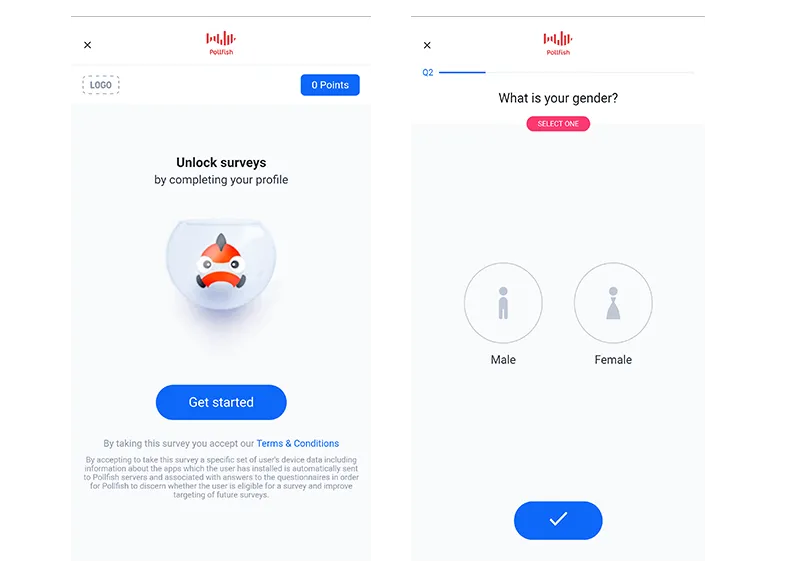
This can also be designed as an incremental set of steps that a user must complete to earn a reward. For example, Dropbox asks new users to complete tasks like installing Dropbox on their computer, taking a product tour, and inviting friends to the app. When a user has completed five items on the list, they receive a storage bonus as a reward:
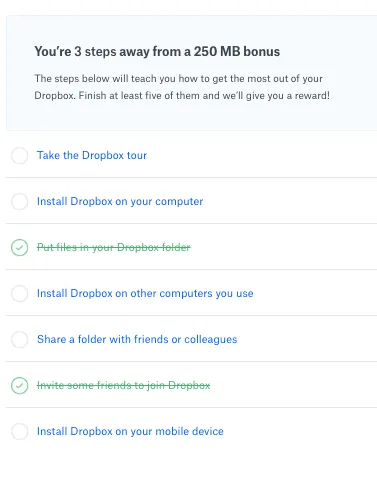
A task to “Complete your profile” would be a great addition to this list to further drive commitment to the product. The notion of “complete 5 items” gives customers a fun goal to work towards while driving product usage.
Interactive Activities and Quizzes
Many brands leverage the power of interactive quizzes and surveys to learn more about each customer.
Online activewear retailer Fabletics does this by asking new members to take a short quiz to receive their first VIP member offer.
By collecting data on customer style preferences, clothing size, and workout routines, Fabletics can be confident that they’re creating the right inventory for their overall customer base, and be able to make personalized suggestions when communicating with each customer.
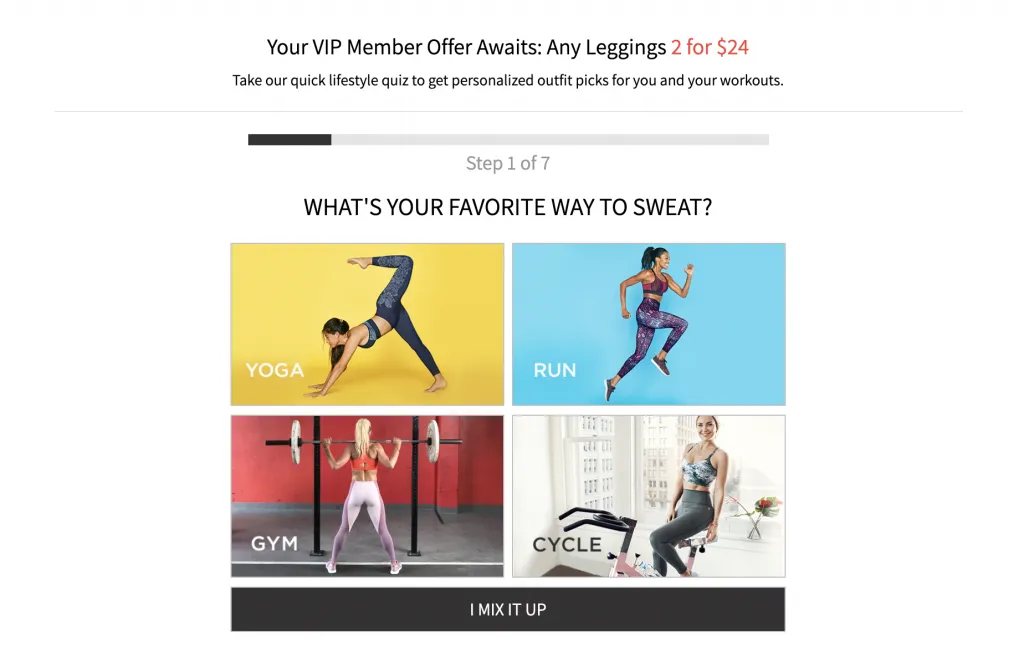
It’s a fun way to collect data and personalize your offerings, all while exposing the customers to your product.
While the methods above are by no means an exhaustive list of data collection methods, keep these points in mind when asking for customer information:
Do:
- Have a plan for how you will use the data
- Only ask the questions that will provide useful answers
- Offer a reward in exchange for the data
- Let customers edit their information later
- Indicate why you’re asking for certain information
Don’t:
- Send a long survey asking for customer data all at once
- Ignore legal requirements (ie. GDPR regulations)
- Ask at the wrong time (ie. don’t ask a long list of questions when a customer is trying to complete a purchase)
External Resources:
3 - What do you do with this information?
How do you use your new data to interact meaningfully with customers and motivate participation in your loyalty program and with your business in general?
If you can show customers that you’re putting their data to good use to improve their experience with your loyalty program, they’ll be more willing to offer details in the future.
Here are a few ways you can use customer data to improve loyalty program participation and satisfaction:
Segment customers to provide relevant offers
The most obvious and important way to use your data is to provide relevant offers and suggestions based on deliberate customer segments.
We can all agree that it’s not very motivating to receive communications from a brand that are in no way relevant to us. In fact, 36% of members say they will abandon a loyalty program if the communications are irrelevant to them.
When you provide relevant suggestions (rewards, products, deals, etc.) for customers to engage with, you’re more likely to meet their needs. When a customer’s needs are satisfied, they’re more likely to continue the relationship with your brand.
While customer segmentation lends itself to a more lengthy discussion, here are a few ways in which you can segment your loyalty offers to customers, plus examples:
Based on activity
- Recent purchase history: Instead of offering a reward for a general review of your brand, ask a user to rate the product or service that they recently purchased.
- Time since last purchase: Send a discount coupon inviting users to browse your new offerings if it’s been a while since their last purchase.
- Product usage: Incentivize feedback and referrals from your customers who use your app the most.
Based on characteristics
- Demographics: Create a VIP membership tier exclusively for university students.
- Milestones: Offer a yearly reward to customers on their birthday, or to celebrate time since they became a customer.
- Geographic area: Send a special offer to all customers in a target area to accelerate your expansion efforts.
External Resources:
Offer multiple ways to earn rewards
Personalization doesn’t always have to mean knowing a customer’s favorite color or shoe size.
We’re advocates for building a loyalty strategy that targets all points of the customer lifecycle, but not just because it extracts the most value from every customer interaction.
Giving users ways to earn rewards from the moment they land on your website to the day they give their first referral is a unique way to personalize their experience. For example, a new user will be more inclined to complete their profile in exchange for a reward rather than refer a friend, as this speaks to how familiar they are with your brand so far.
This strategy also shows customers that you appreciate their genuine engagement with your brand, and aren’t just waiting for them to make more purchases.
To learn more about rewarding customer behavior throughout the lifecycle, check out this article.
Personalize all program communications and interactions
A customer’s name is the most basic piece of customer information that can greatly impact your loyalty program communications.
As Dale Carnegie says, “A person’s name is to that person, the sweetest, most important sound in any language.”
According to data from Experian, personalized email communications have 29% higher unique open rates and 41% higher unique click rates than generic messages (source). Further data suggests that when an email is not personalized, 52% of customers say they’ll find somewhere else to shop.
Where to use a customer's name:
- In emails and other notifications: Experiment with using a customer’s first name in the email subject lines and salutations, plus in SMS or other push notifications.
- With personalized referral codes: Asking a customer to share referral code “EMILY098” with their friends is much more inviting than asking them to share code “67HFKD989dCC”.
- In a customer's account page: Like in the screenshot below for Indigo’s Plum Rewards, even a simple statement of the customer’s name next to their point balance makes it feel like the company is communicating directly to the user.
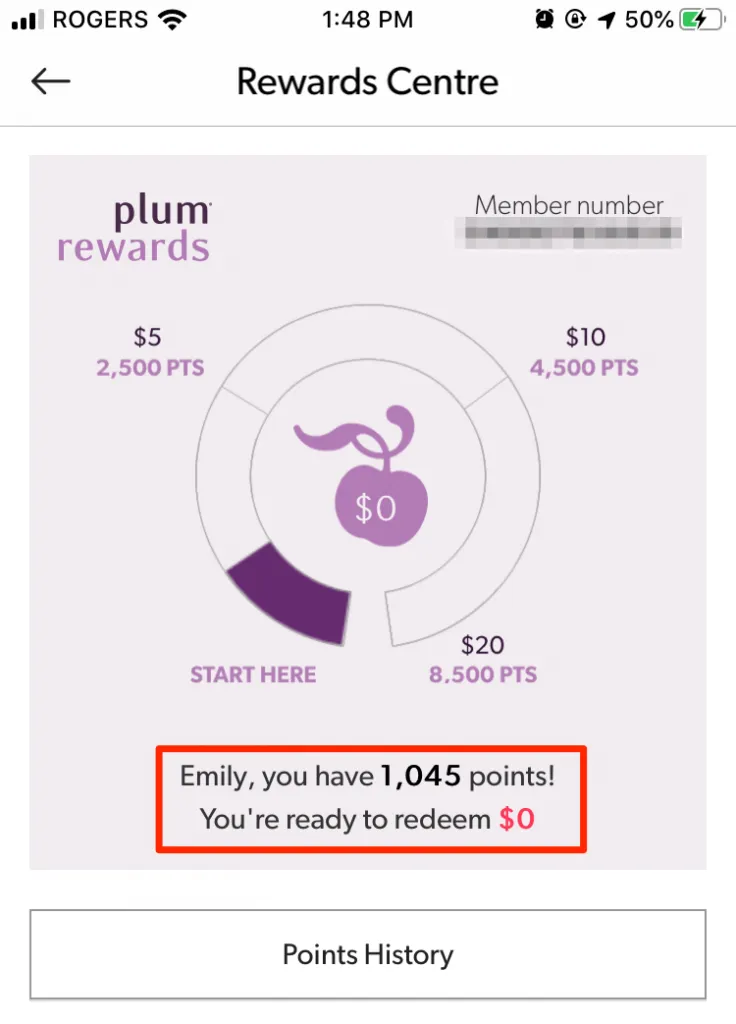
Highlight each customer’s loyalty program activity
Running a loyalty program requires tracking (whether manually or automated with software) of points, referrals, and any other relevant activity to properly trigger rewards. How can you share this information with each customer in a way that drives more participation?
- Create dashboards
When a user logs into your digital product or service, give them an easy place to find all information related to their loyalty points and rewards, plus prompts for how to earn more rewards.
- Motivate progress towards a reward goal
Instead of notifying all loyalty program members that they can “earn a reward after 10 purchases”, let each member know what they need to do to earn their next reward.
This was leveraged in a loyalty program by shoe retailer DSW, where customers received an email with how many points they needed to receive a $10 certificate. The email also contained:
- Other deals the customer was eligible for
- How much the customer has saved since being a member
- How many points the customer has earned
The campaign reportedly saw a 64% lift in email open rates, and a 13% increase in click-through rates.
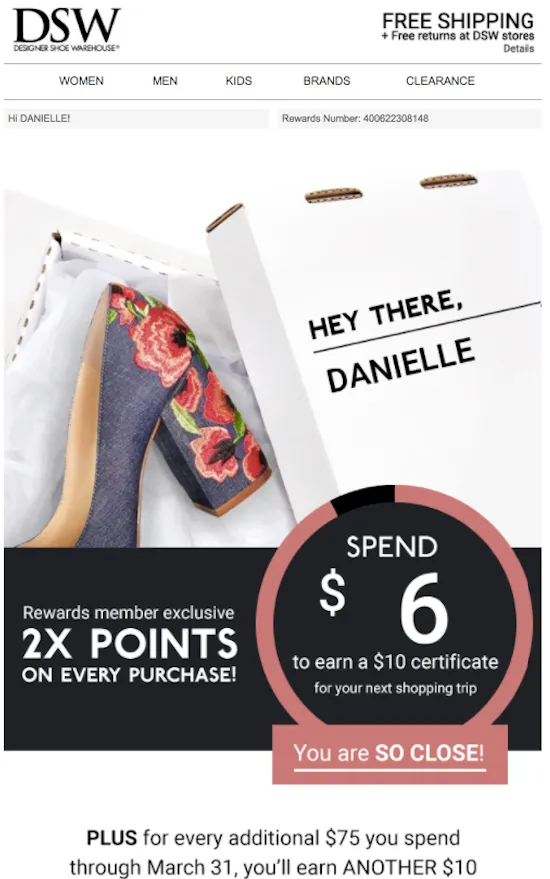
- Recognize your top users
Customer segments can also be created by using loyalty program data. By reaching out individually to your top customers, you fuel their social esteem and reinforce their inclusion in an elite group.
Segments can also be created for your idle users who have not earned rewards, by encouraging them to complete simple in-app actions or tasks that introduce them to your reward offerings.
The bottom line is to make sure you’re using customer loyalty program data in a way that makes their experience easier and more rewarding. To visualize this, let’s consider the case of sending a generic points email to customers versus sending an email with each customer’s individual reward balance:
Scenario 1: Company sends a generic email to all customers
Customer receives email --> logs in to website --> locates points balance --> calculates how many points they need to earn the next reward --> finds how to get more points --> takes action to earn more points.
Given the number of steps, there are a lot of things that could go wrong and cause the customer to abandon. The user might forget their password, navigate away to do a calculation, search for the right information etc.
Scenario 2: Company sends a personalized email using individual data
Customer receives email --> knows how many points they need for next reward --> clicks prompt to earn more points.
With little room for hurdles, the customer is more likely to earn more rewards and continue their participation.
Final Thoughts
While personalization should be at the forefront of all marketing initiatives, use this three-step approach to improve customer satisfaction with your loyalty programs.
To learn more about designing a successful loyalty strategy in the digital economy, sign up for the Digital Loyalty Academy today for free!
